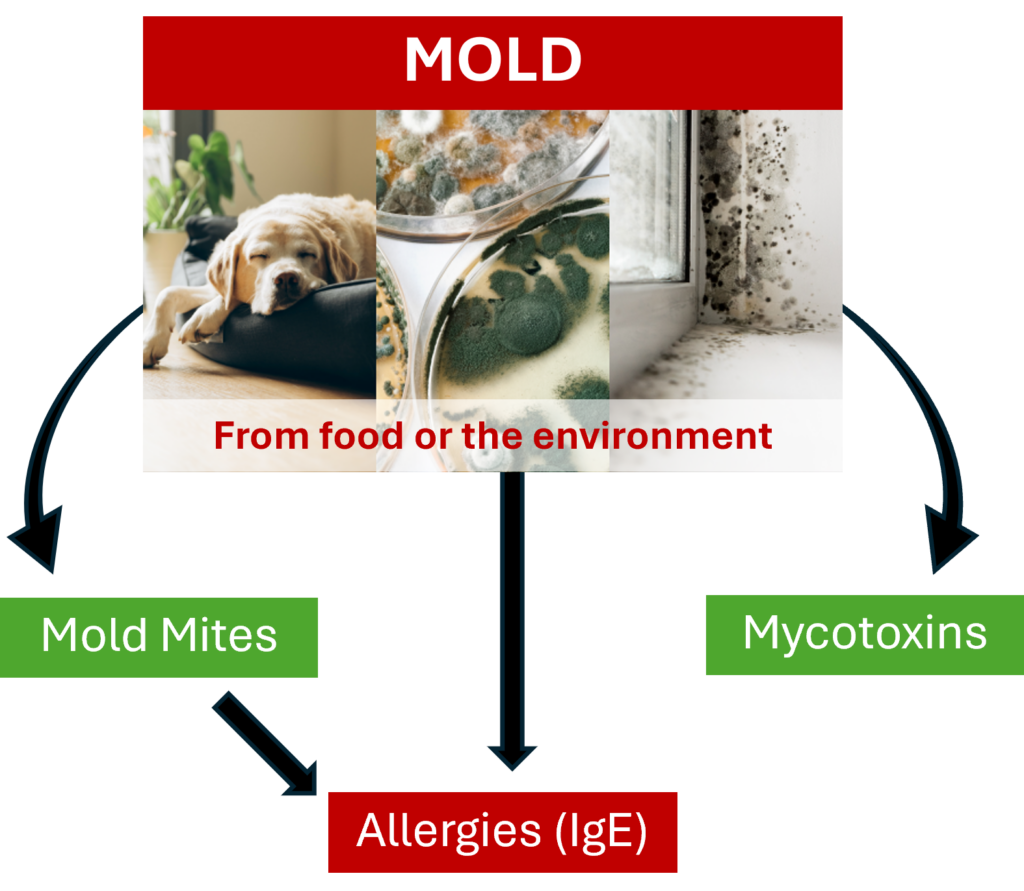
Mold mites (typically Tyrophagus putrescentiae) thrive in environments with high humidity and mold growth. These mites feed on mold spores and other organic matter, making mold-contaminated areas ideal habitats. Allergies to mold mites in companion animals often present as respiratory issues, dermatitis, or itching. The molds associated with mold mites are often the same molds that can produce mycotoxins, creating a compounded risk.
Common Molds Associated with Mold Mites and Mycotoxins Produced
| Mold (Genus/Species) | Associated Mycotoxins | Typical Environment |
|---|---|---|
| Aspergillus flavus | Aflatoxins (B1, B2, G1, G2) | Stored grains, corn, nuts, damp areas |
| Aspergillus niger | Ochratoxin A | Damp foodstuffs, fruits, coffee beans |
| Aspergillus fumigatus | None directly, but allergenic properties | Indoor damp environments, compost |
| Penicillium expansum | Patulin | Spoiled fruits, damp indoor areas |
| Penicillium chrysogenum | None (allergenic mold) | Damp walls, wallpaper, indoor air |
| Cladosporium species | None directly, but allergenic properties | Damp walls, wallpaper, indoor air |
| Fusarium species | Fumonisins, Zearalenone, Trichothecenes | Damp grains, corn, cereals |
| Alternaria alternata | Alternariol, Alternariol monomethyl ether | Damp grains, corn, cereals |
| Stachybotrys chartarum | Trichothecenes | Water-damaged buildings, drywall |
| Mucor species | None directly, but allergenic mold | Soil, decaying organic matter, damp areas |
Yellow Highlighted Toxins: Indicate toxins tested in the VDI Mycotoxin Panel
Key Points:
- Mold mites feed primarily on Aspergillus, Penicillium, and Cladosporium species because these molds grow readily in humid indoor environments and on stored organic matter.
- Aspergillus flavus, Penicillium expansum, and Stachybotrys chartarum are particularly concerning as they produce potent mycotoxins:
o Aflatoxins (Aspergillus flavus) are hepatotoxic and carcinogenic.
o Patulin (Penicillium expansum) is toxic when ingested via spoiled fruits.
o Trichothecenes (Stachybotrys chartarum) cause severe respiratory and immunosuppressive effects. - Cladosporium and Mucor species are allergenic but do not produce significant mycotoxins. However, they can exacerbate allergies and respiratory conditions.
- Mold mites not only act as allergens themselves (causing atopic dermatitis or respiratory issues in pets) but also serve as indicators of mold contamination, which increases the likelihood of mycotoxin exposure for both pets and humans.

Health Impact on Companion Animals:
- Respiratory issues: Triggered by inhalation of mold spores or mold mite allergens.
- Dermatitis: Skin allergies caused by contact with mold mite feces or dead mites.
- Mycotoxin poisoning: Exposure through ingestion of contaminated food or inhalation of mold toxins.
Mitigation Strategies:
- Control humidity: Keep indoor humidity below 50% to inhibit mold growth.
- Air filtration: HEPA filters can reduce mold spores and mite allergens.
- Regular cleaning: Clean surfaces prone to moisture and address water leaks promptly.
- Food storage: Ensure dry pet food and grains are stored in airtight containers to prevent mold growth.
Relevant Testing Options:
125 IgE allergens
including the mold mite and 6 molds
16 Parameters for determining GI disease in cats or dogs.
16 Mycotoxins
from 5 groups
If environment is contaminated, there may be metal accumulation.
